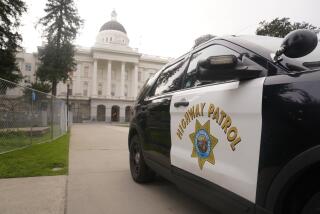California Supreme Court seems likely to uphold forced state furloughs
- Share via
The California Supreme Court appeared inclined Wednesday to uphold the legality of forced furloughs for more than 200,000 state employees, a measure that saved the state more than $1 billion but that infuriated labor unions and inundated the courts with lawsuits.
Members of the state high court, meeting for oral argument in San Francisco, indicated through their questions that the furloughs that began in February 2009 were likely to be ruled legal even though the governor may have lacked unbridled authority to order them.
Such a ruling would save the state from reimbursing workers for the unpaid days off but still limit the authority of future governors to furlough workers without legislative approval.
State employees have filed more than 30 lawsuits challenging the furloughs, and lower courts have been divided over their legality. The governor has used furloughs as a bargaining chip in employee negotiations. Six labor units already have agreed to pension cuts, partly in exchange for immunity from furloughs.
In the cases before the court, Schwarzenegger had ordered workers to take mandatory unpaid days off beginning in February 2009, as the state was running out of cash, through June 2010. Schwarzenegger began furloughing workers again in August to conserve cash during a budget impasse that has dragged 10 weeks into the new fiscal year.
An attorney for Schwarzenegger told the court that the governor has unilateral authority to order unpaid furloughs because of his status as the state’s chief executive officer.
Justice Joyce L. Kennard noted the court might disagree but still decide that the Legislature “approved of the furloughs” when it passed a revised budget in early 2009 that reflected the specific amount in savings they were projected to bring.
Justice Ming W. Chin appeared to agree. “They could have done this as implicit approval of the furloughs,” he said.
Lawyers for state employees argued that the governor was authorized only to lay off workers, freeze hiring or negotiate for furloughs.
“He has all these options that are lawful,” argued Patrick J. Whalen, representing one of the employee groups. “He chose the one that was unlawful.”
Chief Justice Ronald M. George questioned why labor would accept the governor’s authority to lay off but not to furlough, “a less drastic measure.”
Chin also appeared troubled by the contention that layoffs would have been less problematic. The amount saved by furloughs would have required tens of thousands of layoffs, and the savings would not have been immediate, a lawyer for Schwarzenegger said.
“Are you really arguing that furloughs are not less drastic than laying off tens of thousands” of employees, Chin asked an employee lawyer.
Whatever the court decides, the financial impact is likely to be felt by the courts as well as the rest of state government. All seven members of the state high court and most of the state’s judges voluntarily cut their pay by one day a month from September 2009 to June 2010, and many court employees continued to be furloughed.
In another case, the court appeared skeptical of arguments that Schwarzenegger lacked the authority to cut nearly $500 million in health and welfare spending from the state budget in 2009.
Opponents of the cuts contended that governors could use line-item vetoes only to eliminate new spending. Schwarzenegger further cut budget appropriations that the Legislature had already trimmed.
Decisions in both the furlough and the veto cases are expected within 90 days.
Times staff writers Evan Halper and Shane Goldmacher contributed to this report.
More to Read
Sign up for Essential California
The most important California stories and recommendations in your inbox every morning.
You may occasionally receive promotional content from the Los Angeles Times.











